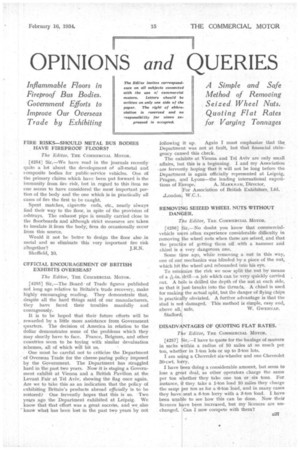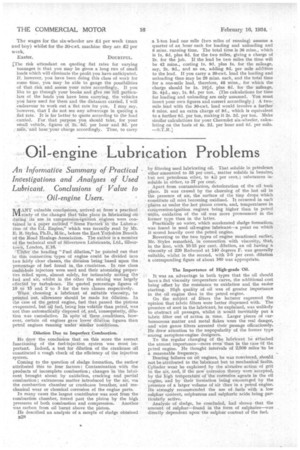OPINIONS and QUERIES
Page 37

Page 38

If you've noticed an error in this article please click here to report it so we can fix it.
FIRE RISKS—SHOULD METAL BUS BODIES HAVE FIREPROOF FLOORS?
The Editor, THE COMMERCIAL MOTOR,
[4254] Sir,—We have read in the journals recently quite a lot about the development of all-metal and composite bodies for public-service vehicles. One of the primary claims which have been put forward is the immunity from fire risk, but in regard to this item no one seems to have considered the most important portion of the body and the one which is in practically all cases of fire the first to be caught. Spent matches, cigarette ends, etc., nearly always find their way to the floor, in spite of the provision of ashtrays. The exhaust pipe is usually carried close to the floorboards and although strict measures are taken to insulate it from the body, fires do occasionally occur from this source.
Would it not be better to design the floor also in metal and so eliminate this very important fire risk altogether?
Sheffield, 10, OFFICIAL ENCOURAGEMENT OF BRITISH EXHIBITS OVERSEAS?
The Editor, THE COMMERCIAL MOTOR.
[4255] Sir,—The Board of Trade figures published not long ago relative to Britain's trade recovery, make highly encouraging reading. They demonstrate that, despite all the hard things said of our manufacturers, they have faced their troubles manfully and courageously.
It is to be hoped that their future efforts will be rewarded by a little more assistance from Government quarters. The decision of America in relation to the dollar demonstrates some of the problems which they may shortly have to face. France, Belgium, and other countries seem to be toying with similar devaluation schemes, all of which will hit us.
One must be careful not to criticize the Department " of Overseas Trade for the cheese-paring policy imposed by the Government. The Department has struggled hard in the past two years. Now it is staging a Government exhibit at Vienna and a British Pavilion at the Levant Fair at Tel Aviv, showing the flag once again. Are we to take this as an indication that the policy of exhibiting Britain's products abroad officially is to be restored? One fervently hopes that this is so. Two years ago the Department exhibited at Leipzig. We know that that effort was a great success, and we also -know what has been lost in the past two years by not following it up. Again I must emphasize that the
Department was not at fault, but that financial stringency caused this check. The exhibits at Vienna and Tel Aviv are only small affairs, but this is a beginning I and my Association are fervently hoping that it will not be long before the Department is again officially represented at Leipzig. Prague, and Lyons—the leading international exposi tions of E6rope. A. MARK HAM, Director, '421r Association of British Exhibitors, Ltd. .London, W.C.1.
REMOVING SEIZED WHEEL NUTS WITHOUT DANGER.
The Editor, THE COmMERCIAL MOTOR.
[4256] Sir,—No. doubt you know that commercialvehicle users often experience considerable difficulty in removing the wheel nuts when these are seized, and that the practibe of getting them off with a hammer and chisel is a very dangerous one.
Some time ago, while removing a nut in this way, one of our mechanics was blinded by a piece of the nut, which hit the wheel and rebounded into his eye.
To minimize the risk we now split the nut by means of a h-in. job which can be very quickly carried out. A hole is drilled the depth of the nut at each side, so that it 'just breaks into the threads. A chisel is used for making the actual split, but the danger of flying chips is practically obviated. A further advantage is that the stud is not damaged. This method is simple, easy and, above safe.
Stafford W. GWENNAP.
DISADVANTAGES OF QUOTING FLAT RATES.
T)r Editor, THE COMMERCIAL MOTOR. [4257] Sir,—I have to quote for the haulage of manure in sacks Within a radius of 10 miles at so much per ton, whether in 1-ton lots or up to 3-ton lots. I am using a Chevrolet six-wheeler and one Chevrolet 30-cwt. lorry.
I have been doing a considerable amount, but seem to lose a great deal, as other operators charge the same per ton %Ai hether they take one ton or six tons, For instance, it they take a 1-ton load 10 miles they charge the sane per ton as for a 6-ton load, and in many cases they have sent a 6-ton lorry with a 3-ton load. I have been unable to see how this can be done. Now their licences have been increased, but my licences are unchanged. Can I now compete with them?
The wages for the six-wheeler are £4 per week (man and boy) whilst for the 30-cwt. machine they axe £2 per week.
Exeter. DOUBTFUL.
[The risk attendant on quoting flat rates for varying tonnages is that you may be given a long run of small loads which will eliminate the profit you have anticipated. If, however, you have been doing this class of work for some time, you may be able to gauge the possibilities of that risk and assess your rates accordingly. If you like to go through your books and give ine full particulars of the loads you have been carrying, the vehicles you have used for them and the distances carried, I will endeavour to work out a flat rate for you. I may say, -however, that I do not see any advantage in quoting a flat rate. It is far better to quote according to the load carried. For that purpose you should take, for your small vehicle, figures of 2s. 6d. per hour and 8d. per , mile, and base your charge accordingly. Thus, to carry
a 1-ton load one mile (two miles of running) assume a quarter of an hour each for loading and unloading and 6 mins, running time. The total time is 36 mins., which is is. 6d. plus 6d. for the two miles, giving a charge of 2s. for the job. If the lead be two miles the time wilt be 42 mins., costing is. 9d. plus Is. for the mileage, say, 2s. 9d., and so on, adding 9d. per mile addition to the lead. If you carry a 30-cwt. load the loading and unloading time may be 20 mins. each, and the total time for a one-mile lead, therefore, 46 mins , for which the charge should be is. 101d. plus 6d. for the mileage, 2s. 40., say, is. 8d. per ton. (The calculations for time for loading and unloading are only assumed. You must insert your own figures and correct accordingly.) A twomile lead with the 30-cwt. load would involve a further 6 mins. and an extra charge of 9d., which is equivalent to a further 6d. per ton, snaking it 2s. 2d. per ton. Make similar calculations for your Chevrolet six-wheeler, calculating on the basis of 4s. 2d. per hour and 4d. per mile. —S.T.R.]




















































































